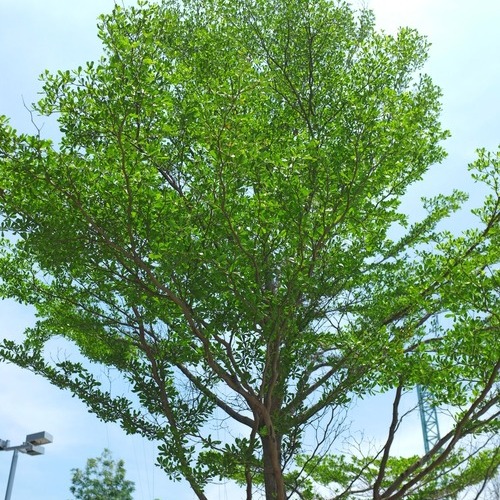
Can you change a tree’s growth pattern?
While trees can add beauty to the landscape of a business or home, they can also pose a problem if their growth pattern becomes an irritant. Once upon a time, the answer to that was to cut the tree down, but today, tree cabling and bracing have given us a way to keep the trees and redirect their growth pattern. If you’re interested in tree cabling and bracing in Fort Worth, TX our professionals can be there to help with this process. Give us a call at (817) 717-7737 if you’re looking for more information.
What is tree cabling and bracing?
Tree cabling and bracing are a method of supplemental structural support to a tree that will reduce any risk of multiple stems and weak branches failing. The cables typically consist of exceptionally strong steel cables that are installed in the upper crown of a tree and attached by bolts. Cabling limits the movement of the branches that are supported so they risk breaking and failing in high winds and storms.
The tree bracing is done with threaded rods that are installed where the weak branches and multiple stems meet. This provides them rigid support, from the force of winds that can twist them, causing them to bend and break. Tree cabling and bracing were invented in the first part of the 20th century and have become the industry standard that arborists use today.
Are the different types of tree cabling and bracing?
Tree cabling and bracing are always mentioned in the same sentence, but they are two distinct processes. When we talk about tree cabling, there are two different types:
- Static Tree Cabling: As mentioned above, the typical method uses an exceptionally strong steel cable that is fastened with bolts to the tree and secured with lag bolts or steel eye nuts. A tree static cabling system is a method that will reduce the risks of co-dominant stem failure.
- Dynamic Tree Cabling: This type of tree cabling uses special elastic components that allow some movement of the tree branches, which will prevent failure. This method is not recommended if a tree t has already started failing and needs maintenance and monitoring.
When we talk about tree bracing, this technique is done by installing metal rods where two co-dominant branches converge. This reduces the risk of branches breaking away by limiting the movement of tree parts like the branches, limbs, and trunks. The tree bracing process is typically done in conjunction with cabling (hence the tree cabling and bracing term) and pruning. This process provides proper protection for the tree.
Is tree cabling and bracing a good option?
Tree pruning should be the first thing done when improving the tree’s structure. Tree cabling and bracing methods cannot save dead, dying, or decaying branches and prevent them from falling. Because tree cables are flexible, they won’t restrict growth but will reduce movement, while the bracing stabilizes the tree, and gives it the needed support. When installed by a tree professional, tree cabling is discreet so that the landscape aesthetics are not disturbed.
How long does tree cabling and bracing last?
When tree cabling and bracing are done properly by a trained professional, it can last up to 40 years. However, frequent inspections should be done on the tree by a licensed arborist. If the tree is still growing, the tree cabling may need to be redone or replaced every three to four years.
How expensive is tree cabling and bracing?
While you have a budget in place, you need to choose a professional who is experienced and licensed. Because tree cabling and bracing are done on healthy trees, ultimate care needs to be exercised to minimize any possibility of damaging the tree. The process can cost up to $500 or more depending on the size of the tree and how many braces and cables are needed.
When should tree cabling and bracing be done?
Tree cabling and bracing are recommended when a tree has indications of structural weakness. This is done by inspecting the tree for the following:
- The bark
- Codominant stems
- Large, overextended tree branches
Tree cabling and bracing are also used when there is a risk of damage due to any part of a tree failing.
What are the benefits of tree cabling and bracing?
Tree cabling and bracing are a combination process that prepares the trees for severe weather, especially if they are at a high risk of failing. The benefits you can expect include:
- Lowered Risk of Property Damage and Failure: An unsupported tree is at risk of being exposed to heavy rains and high winds that are typical with storms that come through the Dallas/Fort Worth Texas area. The process of tree cabling and bracing will stabilize trees that may have weak branches and brace the trunk and any large weak areas that may split.
- Encourages Strong Growth: As tree cabling and bracing are an ideal defense mechanism during questionable weather, they also assist the weak areas to grow stronger. This will minimize weak areas in the future that have a risk of failing.
- Encourages Healing: Tree cabling and bracing can help treat damaged trees by providing structural support nurturing growth and assisting in healing and repairing.
In Closing
It can be tempting, and easier, to just let trees grow in their natural process. But if you’re concerned with the safety of your home and surrounding area, tree cabling and bracing are the best insurance and reinforcement. If you’re looking for any more information, reach out to our professionals and we can answer any questions you may have. Call today at (817) 717-7737.
